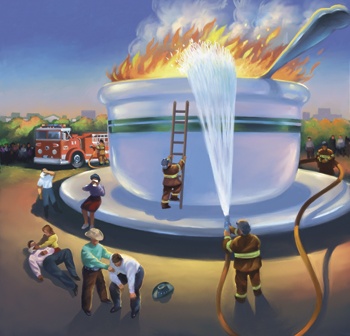I’m craving a good bowl of chili. What I’m hungering for is not that canned brown goop, mind you, but a sure-nuff homemade bowl of red, built from the ground up. I don’t want it made with chili powder, but with the boiled and skinned pulp of genuine chili peppers, dried black in the sun. One other thing. No beans. Beans have no place in my dream bowl of chili.
—Donnis Baggett, The Eagle
Paul Petersen is a big-deal chef, the kind who gets glowing reviews in food magazines for his New Texas cuisine. His Gage Hotel restaurant in Marathon, near Big Bend National Park, has been described as “lovely: comfortable, warm, and unpretentious, yet with an aura of elegance and refinement.” He makes a mean pepper-crusted elk medallion, served with potato gratin and truffled mushroom demi-glace.
So what’s on the restaurant’s bar menu during football season? A bowl of red, of course.
“I don’t think real Texas chili, the kind without any beans, is in any danger of dying out,” says Petersen, who grew up in San Antonio and attended the internationally known Culinary Institute of America. “And it never will. As far as Texas goes, the real bowl of red is going to stay around for a long time.”
That’s some of the best news that those of us who care about these things have heard in a long time. Yes, chili is the official state dish of Texas, and yes, it has a long and storied tradition in the state. Songs have been sung about it, prayers have been written about it, and cook-offs—lots and lots of cook-offs—have been held in its honor. But this is the 21st century, and the food police are everywhere. And chili, that legendary bowl of red, is made mostly of things we’re not supposed to eat much of any more, like beef and fat. Even some franchisees of Chili’s Grill & Bar, the Dallas-based restaurant chain, opt not to include a bowl of red on the menu.
Nevertheless, chili is thriving. “You know, we’ve had requests to put vegetarian chili on the menu,” says Paul Ryan, who married into the first family of Texas chili. He and his wife, Kathleen Tolbert Ryan, run Tolbert’s, a restaurant in Grapevine, where they carry on the tradition started by Kathleen’s father, legendary newspaperman and pioneer “chilihead” Frank X. Tolbert. “But we haven’t done it yet. It goes against the grain. Chili without meat? Aw, c’mon. What kind of chili would that be?”
What makes a bowl of red? Everyone knows what chili is—beef and fat, water or stock, and a kitchen pantry full of spices. No beans—historically speaking, Texas chili was made with what was on hand, including meat and chile peppers—and maybe some cheese and onions on the side. Brown the meat in the fat, add the spices and liquid, and cook until tender. Getting past that point is another story. Chiliheads are not big on detail.
“Well, I can tell you that most of us use 80-20 (80 percent lean and 20 percent fat) beef,” says Ken Rodd, a chilihead who handles public relations for the Chili Appreciation Society International, which runs the annual Terlingua International Chili Championship. “And I can tell you that most of the best competitors use specialty-store spices these days instead of grocery-store spices.”
Other than that, you’re on your own. Recipes are top secret. Ask Paul Ryan how Tolbert’s grinds its beef, and he hems and haws. Ask Jim Heywood, a chilihead who teaches at the Culinary Institute of America, about his recipe, and he is appropriately vague. You can find recipes on the Internet, even on the websites of groups that sanction cook-offs. But are those there to inform or to lead would-be chiliheads astray, a bit of intentional misdirection?
There is more to this recipe reticence than tradition and paranoia. Chili is simple, which makes every ingredient, no matter how minor, important. A dash of this instead of a bit of that could be the difference between winning Terlingua and not even making the finals. It’s also one reason cooks are searching for better quality spices instead of the staples from years past, such as Adams and Gebhardt. Pendery’s in Fort Worth is a popular supplier; it sells almost two-dozen chili powder blends, including several concocted by Terlingua winners.
In fact, says W.C. Jameson, a Hill Country author who has written two books about chili, this simplicity is one reason the dish has remained so popular for so long. Anyone can make it, and he or she can use almost anything in the refrigerator to do so, including rabbit, armadillo, venison, ostrich, potatoes, white beans and tomatillos. Tolbert and Wick Fowler, of chili powder fame, added masa harina (Mexican corn flour), which to this day baffles many modern chiliheads.
But that’s just the start. How about Cincinnati chili, a thinner, sauce-like concoction, made with allspice and cider vinegar and served over spaghetti? (Thankfully, says Jameson, it’s only popular in and around Cincinnati.) Along some parts of the East Coast, chili is made with canned pork and beans, while lima beans are used in Michigan. And there is an entire generation of Mid- western baby boomers whose mothers browned grocery store hamburger and then mixed it with something called chili hot beans—canned kidney beans in a spicy gravy.
In this, chili has come a long way from its roots. There are any number of colorful stories about its origin: Some say it was invented by chuck wagon cooks on cattle drives, or that it migrated from Mexico to Texas before the Civil War, carried by poor immigrants who couldn’t afford anything but the cheapest cuts of meat and some dried chiles. There are tales of San Antonio’s colorfully dressed chili queens, who sold chili on the city’s streets in the half century before the Depression. Each story, says Jameson, probably has some truth to it.
The dawn of a new era: Chili’s modern history begins in the 1960s, when Tolbert published his seminal chili history, A Bowl of Red. A few years later, Tolbert and Fowler held the first Terlingua event. By the 1980s, the idea of the chili cook-off had caught hold, and today, there are two major cook-offs in Terlingua, plus two national sanctioning organizations that hold local and regional chili contests. Rodd’s chili appreciation group has seen the number of cook-offs it holds double in the past decade, while the International Chili Society sponsors some 200 cook-offs a year. Both note that participation is better than it has ever been. Even in the latter group, which includes events for green chili and salsa, the prestige competition is traditional chili.
“Green chili has become accepted over the years,” says Heywood, who competes in chili society events. “But traditional chili hasn’t become any less popular. There will always be people who think of that when they think of chili.”
Irving’s Doris Coats, whose 1991 Terlingua win is one of her many titles, has been cooking in chili contests since 1977. She and her husband, Bob, whose numerous titles include winning Terlingua in 1999, see chili cook-offs as not just something that’s fun but as an important ingredient for Texas and Texans.
“The taste for real chili never really leaves,” she says. “It’s like the bluebonnet. There are things about Texas that you just don’t want to let go of. Texans are the proudest people in the world, and chili is one of the things that we have to be proud of.”
Especially when it doesn’t have beans.
——————–
Jeff Siegel is a Dallas-based food writer who has written about salsa and chicken-fried steak for Texas Co-op Power.


